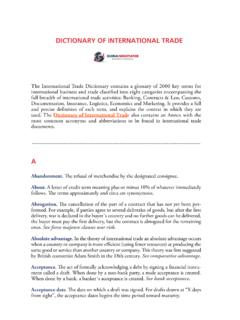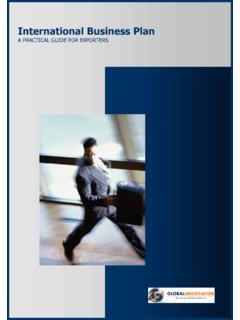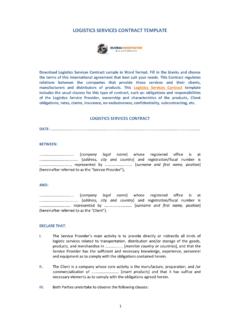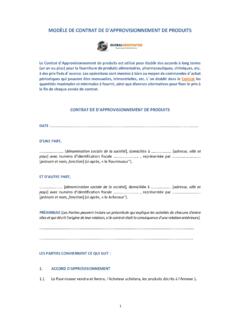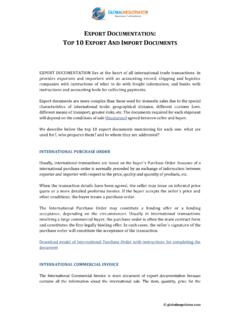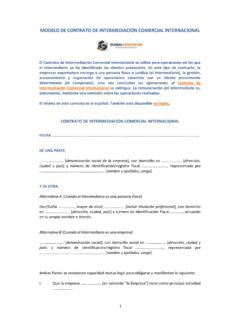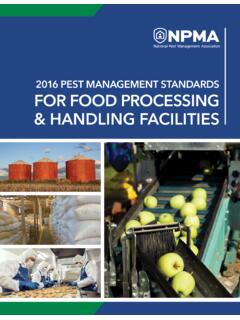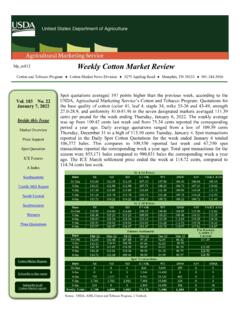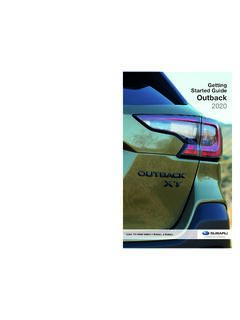Transcription of Practical Guide to Incoterms 2020 - Globalnegotiator
1 Practical Guide TO Incoterms 2020No part of this publication may be reproduced, stored in a retrieval system or transmitted in any forms or any means, electronic, mechanical, photocopying, recording or otherwise, without the prior written permission of the publisher. Copyright Global Marketing Strategies , 2019107, Drayton GardensLondon SW1 9QT. WHAT ARE THE Incoterms RULES? ..6 Classification of the Incoterms 2020 ..7 Changes in the Incoterms 2020: General and specific ..9 Customs clearance: export, transit and import ..14 Variants of the Incoterms ..16 WHAT ARE THE Incoterms USE FOR? ..18 Place of delivery ..18 Documents and customs procedures ..21 Transfer of risks in transport ..23 Allocation of logistics costs.
2 24 OBLIGATIONS OF THE SELLER AND THE BUYER ..31 EXW Ex Works ..32 FCA Free Carrier ..40 FAS Free Alongside Ship ..48 FOB Free on Board ..56 CPT Carriage Paid To ..64 CFR Cost and Freight ..71 CIP Carriage and Insurance Paid to ..79 CIF Cost, Insurance and Freight ..88 DAP Delivered at Place ..97 DPU Delivered at Place Unloaded ..104 DDP Delivered Duty Paid ..112 TEN KEYS FOR THE PROFESSIONAL USE OF THE Incoterms ..120 WHAT ARE THE Incoterms RULES?WHAT ARE THE Incoterms RULES?6 What are the Incoterms rules? The Incoterms rules (INternational COmmerce TERMS) are a total of eleven terms published by the International Chamber of Commerce (ICC) based in Paris, which define the conditions of supply of goods in international sales transactions.
3 The first edition was published in 1936 and subsequently there have been continuous revi-sions and updates (usually every ten years) to that currently in force which is the Incoterms edition will probably be in effect for a decade, until Incoterms 2020 rules are contained in Publication No. 723 EF of the Interna-tional Chamber of Commerce (ICC) in a bilingual English-French edition. A copy of this publication can be acquired, in both hard copy and e-book format, on the website and preparation of the Incoterms 2020 was carried out by a group of experts called the Drafting Group comprising of ten people. Traditionally, these experts came from European Union countries (mainly France and the United Kingdom) but in this occasion experts from other countries such as Australia, China, the United States and Turkey have been incorporated.
4 Although most experts have a legal back-ground, three of them are specialists in logistics and customs, which has made possi-ble for the new version to use an easy language (plain English) rather than a complex one (legal English); in this sense, closer to the practice of international process of preparing the Incoterms 2020 was long. The Drafting Group met for the first time in Paris, in April 2017, and delivered the final version in May 2019. During these two years, more than 3000 suggestions and comments were received through the ICC National Committees in the different countries that contributed to supplement the text. The final version was published in September 2019, the year in which the centenary of the International Chamber of Commerce was Incoterms are private law rules and are not underpinned by the laws of any country or by a supranational organisation.
5 They are a set of rules by businesses (ex-porters and importers) within the International Chamber of Commerce to regulate some aspects of foreign trade Incoterms do not have the force of law and therefore there is no obligation to use these terms in international trade operations; their use will be conditioned on the acceptance of the parties (seller and buyer) in the sale contract. The effectiveness of the Incoterms is that its rules are widely known and used by different parties in for-eign trade (exporters, importers, carriers, freight forwarders, customs brokers, banks 7 Practical Guide TO Incoterms 2020and insurance companies, etc.). Therefore, the Incoterms rules are very useful for sellers and buyers to agree on terms of delivery of the goods and that the agreement corresponds to rules that are universally 2020: Process of revision and draftingDrafting: April 2017 -May 2019 Publishing: September 2019In effect: January 2020 -December 2029 ExportersImportersLogistics & CustomsBannksICC NATIONAL COMMITEESC ountries-3 EU-2 Australia-1 China-1 TurkeyDRAFTING GROUP10 MembersBackground-7 Legal-3 Log stics & CustomsClassification of the Incoterms 2020 The Incoterms can be classified according to three criteria that all have to do with transport.
6 Mode of transport used, payment for the main (international) transport and transfer of risks in transport. In the classification of the Incoterms 2020, the prevailing approach is the mode of transport of transport used ( Incoterms for any mode of transport and sea Incoterms )The first criterion is the mode of transport used. In the version of the Incoterms 2020, there are seven Incoterms that can be used with any mode of transport (surface, air or sea) or multiple modes (multimodal). Conversely, there are four Incoterms that can only be used with sea transport and inland waterways (canals, rivers, lakes).WHAT ARE THE Incoterms RULES?8 Incoterms for any mode of transport and multimodal transport: EXW, FCA, CPT, CIP, DAP, DPU and DDP.
7 Incoterms , only for sea and inland waterways transport: FAS, FOB, CFR and for the main transport (seller or buyer)The second criterion of classification is the payment of main transport which is the international transport between the country of origin and the country of destina-tion. The Incoterms distinguish between those terms in which the main transport payment is made by the buyer (importer) and those where it is made by the seller (exporter). Incoterms in which the main transport is paid by the buyer: EXW, FCA, FAS and FOB. Incoterms in which the main transport is paid by the seller (exporter): CPT, CFR, CIP, CIF, DAP, DPU and of risks in transporting the goods (at origin or destination)Finally, we should distinguish between those Incoterms in which the obligation to deliver the goods by the seller and, therefore, the transfer of risks in transport occurs in the country of origin, while in other Incoterms the obligation of delivery occurs in the country of destination.
8 Incoterms with transfer of risks in the country of origin: EXW, FCA, FAS, FOB, CPT, CFR, CIP and CIP. Incoterms with transfer of risks in the country of destination: DAP, DPU and the case of Incoterms in C (CPT, CFR, CIP and CIF) should be noted that, although the seller will be paying international transport to the country of destina-tion, the risks of transport are transferred in the country of origin when the goods are loaded onto the means of transport. Hence in the Incoterms CIF and CIP, which incorporate a compulsory insurance transport, it is the seller who takes out and pays the insurance. Although, the beneficiary of insurance is the buyer who bears the risks of Guide TO Incoterms 2020 Classification of Incoterms 2020 AcronymsIncotermMode of transportPayment of main transportTransfer of risks in transportEXWFCACPTCIPDAPDPUDDPEx WorksFree CarrierCarriage Paid ToCarriage and Insurance Paid ToDelivered at PlaceDelivered at Place UnloadedDelivered Duty PaidAny modeAny modeAny modeAny modeAny modeAny modeAny modeBuyerBuyerSellerSellerSellerSellerSe llerOriginOriginOriginOriginDestinationD estinationDestinationFASFOBCFRCIFFree Alongside ShipFree On BoardCost and FreightCost, Insurance and FreightSeaSeaSeaSeaBuyerBuyerSellerSelle rOriginOriginOriginOriginChanges in the Incoterms 2020.
9 General and specificThe Incoterms 2020 rules have not introduced any significant changes as compared to the previous version of 2010. In this regard, the key elements of the 2010 version are retained, in particular: Classification into 11 Incoterms : the sole change is that of the Incoterm DAT (Delivered at Terminal) which is replaced by DPU (Delivered Place Unloaded), although it is rather change in the three-letter name as both terms have the same functions and obligations. Priority of the multimodal Incoterms as compared to the maritime Incoterms : the criterion of the type of transport is retained in order to establish the order of priority of the Incoterms . The multimodal terms (for any mode of transport) are classified first and then followed by the maritime terms given that it is understood that with the widespread use of multimodal transport, the multimodal Incoterms are a much better fit with the reality of international logistics.
10 Similarity in the obligations of seller and buyer: the 10 obligations for each party are retained, although some minor changes have been made (for example, the Inspection of goods section has been taken out and becomes part of Export/ Import clearance ). The order is likewise changed, placing WHAT ARE THE Incoterms RULES?10at the beginning of the section the obligations related to the delivery of the goods and the transfer of risks given that these are considered key aspects in the Incoterms rules. Goods in containers only with multi-modal Incoterms : this change which was one of the most significant changes to the Incoterms 2010 version is re-tained in the Incoterms 2020. If the goods are transported in containers, the In-coterms 2020 rules clearly state that maritime terms must not be used, although the delivery is conducted in a port.
